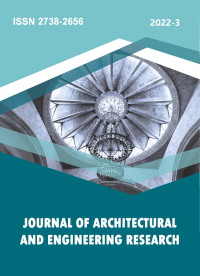Monitoring of Weak and Moderate Earthquakes Using GNSS Technologies
DOI:
https://doi.org/10.54338/27382656-2022.3-006Keywords:
Permanent reference stations, Permanent reference stations, GNSS technologies, deformation, geodynamics, earthquake, deformation, geodynamics, earthquakeAbstract
The geodetic monitoring results of the earthquake in the seismically active area at the Republic of Armenia using GNSS technologies are presented in this article. The necessity of using geodetic tools-equipment, in particular satellite technologies, in the process of seismic studies is substantiated, proving the fact of the validity and reliability of the data. The monitoring results of the horizontal-vertical shifts’ coordinates of the permanent reference stations affected by the earthquake in Armenia on February 13, 2021 at different time intervals (5 days before the earthquake, 2 hours and 10 minutes before and after, as well as at the moment of the earthquake) were analyzed and the graph analyzes were given.
Downloads
References
K.M. Larson, GPS Seysmology. Journal of Geodesy, 83 (3), 2009, 227-233. Doi: https://doi.org/10.1007/s00190-008-0233-x
Susilo, I. Meilano, T. Hardy, M. Al Kautsar, D.A. Sarsito, J. Efendi, Rapid Estimation of Earthquake Magnitude using GNSS Data. The 3rd Southeast Asian Conference on Geophysics, IOP Conf. Ser.: Earth Environ. Sci. 873, Bandung, Indonesia, Nov. 3-5, 2020. Doi: https://doi.org/10.1088/1755-1315/873/1/012063
F. Zedek, L.M. Rolland, T.D. Mikesell, A. Sladen, B. Delouis, C. Twardzik, P. Coïsson, Locating Surface Deformation Induced by Earthquakes Using GPS, GLONASS and Galileo Ionospheric Sounding from a Single Station. Advances in Space Research, 68 (8), 2021, 3403-3416. Doi: https://doi.org/10.1016/j.asr.2021.06.011
J. Paziewski, G. Kurpinski, P. Wielgosz, L. Stolecki, R. Sieradzki, M. Seta, S. Oszczak, M. Castillo, F. Martin-Porqueras, Towards Galileo + GPS Seismology: Validation of High-Rate GNSS-Based System for Seismic Events Characterisation. Measurement, 166, 2020, 108236. Doi: https://doi.org/10.1016/j.measurement.2020.108236
Z. Gao, Y. Li, X. Shan, C. Zhu, Earthquake Magnitude Estimation from High-Rate GNSS Data: A Case Study of the 2021 Mw 7.3 Maduo Earthquake. Remote Sensing, 13 (21), 2021, 4478. Doi: https://doi.org/10.3390/rs13214478
Y. Omer, Y. Servet, I. Cevat, (2014). Determination of 2011 Van/Turkey Earthquake (M=7.2) Effects From Measurements of CORS-TR Network. Geomatics, Natural Hazards and Risk, 5 (2), 2014, 132-144. Doi: https://doi.org/10.1080/19475705.2013.789453
J. Kouba, A Possible Detection of the 26 December 2004 Great Sumatra–Andaman Islands Earthquake with Solution Products of the International GNS Service. Studia Geophysica et Geodaetica, 49 (4), 2005, 463-483. Doi: https://doi.org/10.1007/s11200-005-0022-4
K. Larson, P. Bodin, J. Gomberg, Using 1Hz GPS Data to Measure Deformations Caused by the Denali Fault Earthquake. Science, 300 (5624), 2003, 1421-1424. Doi: https://doi.org/10.1126/science.1084531
S. Miyazaki, K. Larson, K. Choi, K. Hikima, K. Kokepsu, P. Bodin, J. Haase, G. Emore, A. Yamagiwa, Modeling the Rupture Process of the 2003 Tokachi-Oki Earthquake using 1-Hz GPS Data. Geophysical Research Letters, 31 (21), 2004. Doi: https://doi.org/10.1029/2004GL021457
A.A. Margaryan, Research on Deformation Processes on the Geodynamic Polygons with the Use of Modern Satellite Technologies. Scientific Papers of National University of Architecture and Construction of Armenia, 1 (76), 2020, 70-79 (in Armenian).
A.A. Margaryan, Analysis of Data Obtained from Observations of GNSS Technologies. Scientific Papers of National University of Architecture and Construction of Armenia, 3 (78), 2020, 75-82 (in Armenian).
V.I. Kaftan, V.A. Sidorov, A.V. Ustinov, Sravnitel'nyy analiz tochnosti lo-kal'nogo monitoringa dvizheniy i deformatsiy zemnoy poverkhnosti s ispol'zovaniyem global'nykh navigatsionnykh sputnikovykh sistem GPS i GLONASS. Vulkanologiya i seysmologiya, 3, 2017, 50-58 (in Russian). Doi: https://doi.org/10.7868/S020303061703004X
Downloads
Published
How to Cite
Issue
Section
License
Copyright (c) 2022 Anush Margaryan, Suren Tovmasyan, Vahagn Muradyan, Larisa Manukyan

This work is licensed under a Creative Commons Attribution-NonCommercial 4.0 International License.
Creative Commons Attribution-Non-Commercial (CC BY-NC). CC BY-NC allows users to copy and distribute the article, provided this is not done for commercial purposes. The users may adapt – remix, transform, and build upon the material giving appropriate credit, providing a link to the license. The full details of the license are available at https://creativecommons.org/licenses/by-nc/4.0/.













